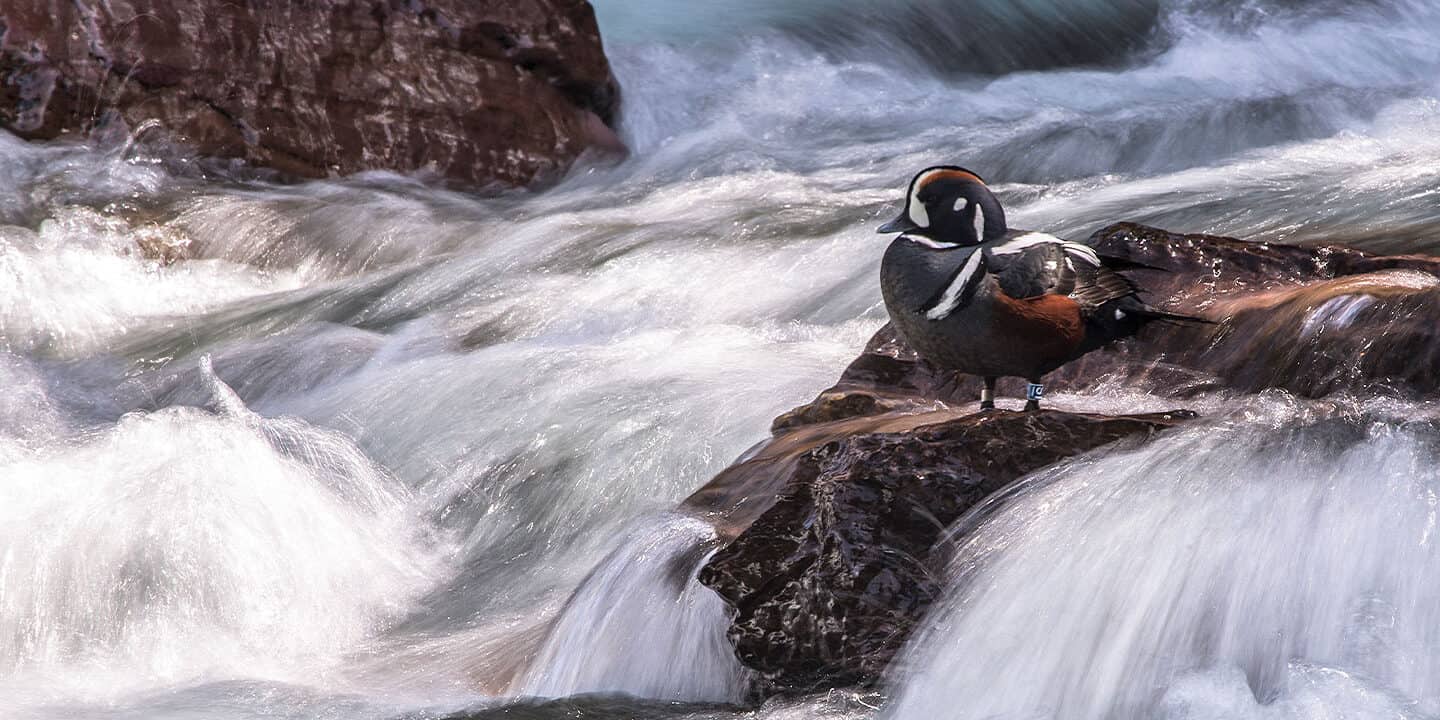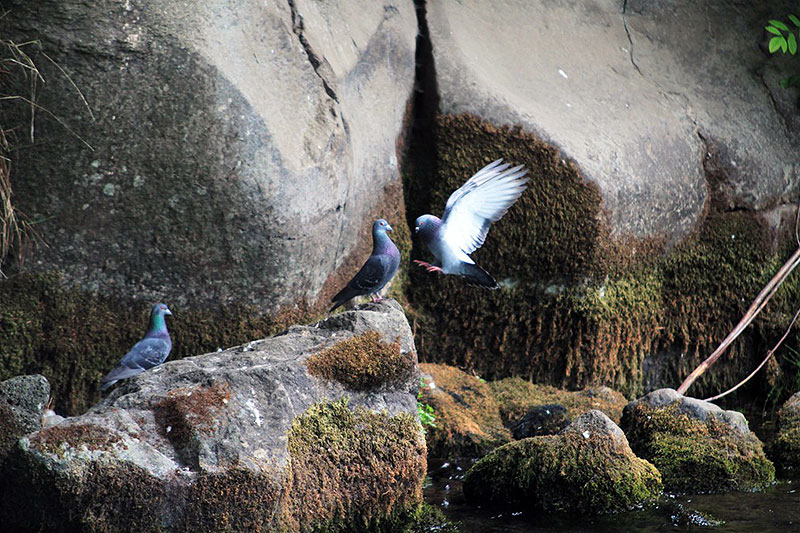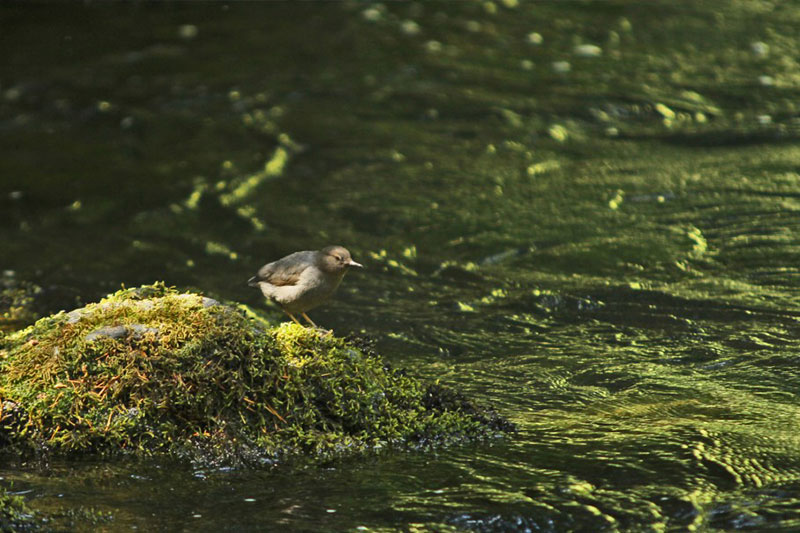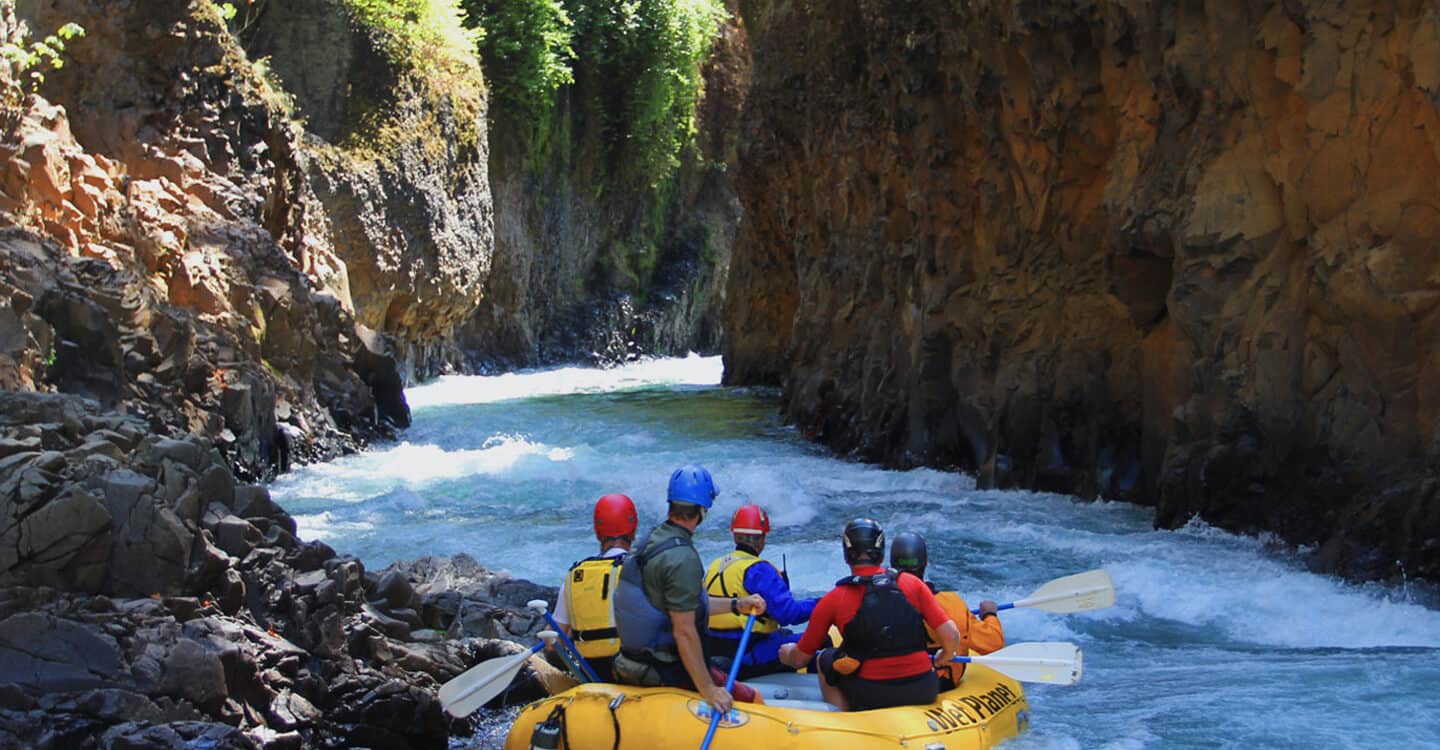Birding and whitewater rafting or kayaking are 2 activities that most people would not normally associate with each other; however, the river is an excellent place to observe birds in the wild. Along the White Salmon River, in the Columbia River Gorge, it is almost inevitable to spot the American Dipper bobbing on the rocks or the Cedar Waxwings and Northern Rough-Winged Swallows swooping over the water hunting flying insects. It’s also typical to see Common Mergansers, Canada Geese, and Mallards resting along the river banks or floating down river. Chances of spotting raptors such as Osprey or a Bald Eagle, are most likely on the full-day rafting trip before or after “the Narrows.” There are a few known Osprey nesting sites along the Lower and Lower-Lower sections of the White Salmon. We’ve compiled a list of birds known to hang out along the White Salmon River, as well as useful information about them, stories of close encounters, and your likeliness of spotting them on your next rafting trip!
“Eco-tourism, like whitewater rafting is a great way to help conserve these important areas for birds so we can keep coming back year after year and appreciating the beauty of our local river birds,” said Miko Ruhlen, local bird expert and owner of Hood River Hobbies.
American Dipper
Description: Grey all over, long legs, short neck and tail.
Distinguishing characteristic: Constantly bobs its body up and down.
Call: “His music is that of the streams refined and spiritualized. The deep booming notes of the falls are in it, the trills of rapids, the gurgling of margin eddies, the low whispering of level reaches, and the sweet tinkle of seperate drops oozing from the end of mosses and falling into tranquil pools.” -John Muir
Diet: Insects, insect larvae, fish eggs, and small fish
Interesting facts: America’s only truly aquatic songbird. They run and “fly” along the current on the bottom of the river, overturning rocks in hunt of prey. They have specially adapted irises that change the shape of their eye to optimize sight under water. Dippers nest near water where misting keeps the moss and woven grass of their nest moist.
Likelihood of spotting one on a half-day trip: Very high
Likelihood of spotting one on a full-day trip: Very high
Notable Sighting: “I see dippers often when paddling on the lower White Salmon! One of my favorite spots to see them is Cave Wave, where they have a nest in the cave wall. It’s cool to see them fly in or out when you’re sitting in the cave! I also love when dippers are perched on rocks in the middle of the river doing their little dipper dance.” – Sharon Saltoon, Kayak Instructor
Cedar Waxwing
Description: Brown crested heads that fade to slate blue toward the tail. Red wingtips and yellow tail-tips and black “robber’s mask” across the eyes.
Distinguishing characteristic: Brilliant red wingtips, yellow tail-tips, and “robber’s mask”.
Call: High-pitched hissy or trilled whistles.
Diet: Mostly berries, however, in summer they supplement their diet with insects, mostly caught in flight.
Interesting facts: Because their diet consists primarily of fruit, Cedar Waxwings sometimes become intoxicated or even die when they encounter over-ripe fruit in the Fall. During the summer Waxwings can often be seen flying low over the river, then swooping upward to “ambush” flying insects from below.
Likelihood of spotting one on a half-day trip: High
Likelihood of spotting one on a full-day trip: High
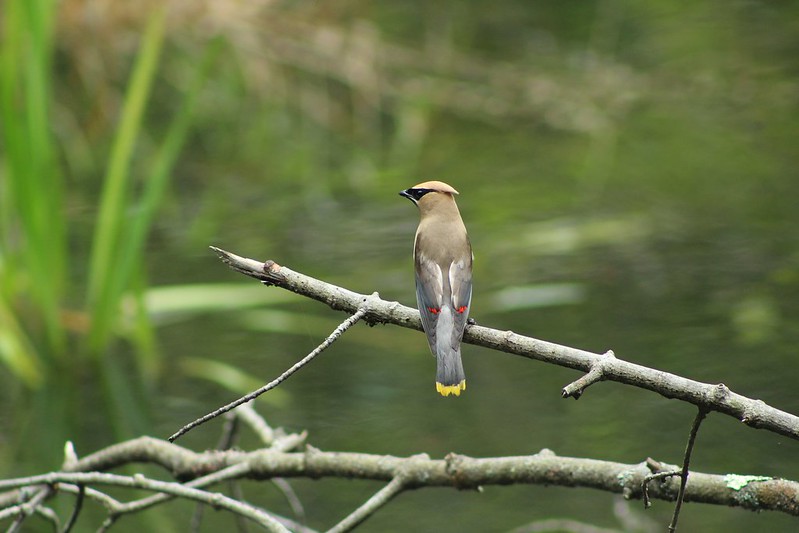
Cedar Waxwing. Photo by Guillermo Alvarez/USFWS via Flickr.
Northern Rough-Winged Swallow
Description: Small, stocky brown bird with long wings.
Distinguishing characteristic: Has a rough, unevenly cut wing edge, only observable with the bird in hand.
Call: Short, low-pitched “brrt” and “jrrr” notes only audible at a close distance.
Diet: Flying insects
Interesting facts: Uses burrows made by other species or digs their own near waterways. It is not known what purpose their rough wing edge serves.
Likelihood of spotting one on a half-day trip: Very high
Likelihood of spotting one on a full-day trip: Very high
Notable Sighting: “I see swallows just about every time I’m on the Lower Klickitat River for a Beginner Kayaking Course! There’s a spot on the river called the “Swallow Cave” because the swallows have nests there. You really get to see them up close and personal!” – Sharon Saltoon, Kayak Instructor
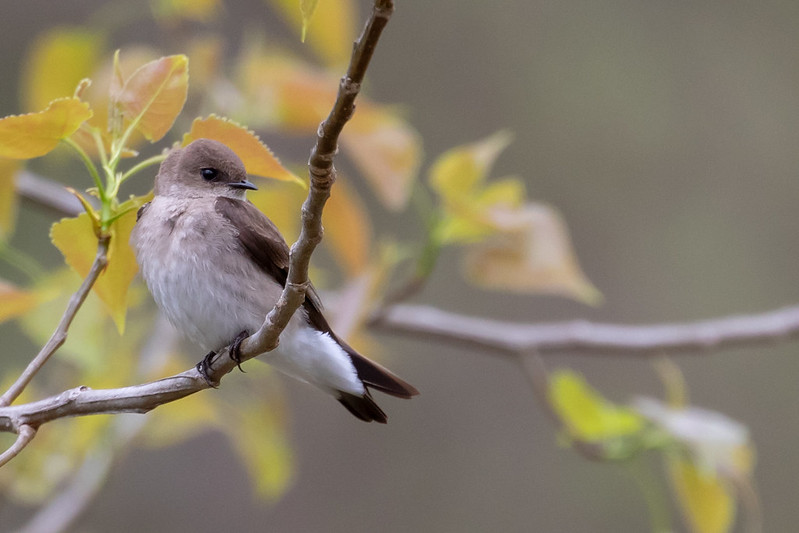
Northern Rough-Winged Swallow. Photo by Shawn Taylor via Flickr.
Common Merganser
Description: Females have grey bodies and a brown head with a characteristic “mohawk” and thin red bill. Males are a magnificent white with green iridescent heads and thin, jagged, red bill.
Distinguishing characteristic: Thin, red bill used for catching fish.
Call: Males are mostly silent. Females make a high-pitched and fast cro cro cro to call ducklings and a low, raspy gruk when threatened.
Diet: Mostly fish and aquatic invertebrates
Interesting facts: Because they often habitat on rivers, females will often act as surrogates for orphaned ducklings separated from their mothers in swift current. Mergansers nest in old log hollows and abandoned woodpecker nests. Juvenile Mergansers leave the nest and are responsible for their own foraging on day 1, eating insects until about day 12 when they switch to fish. Mergansers are expert whitewater boaters, often seen swimming Class V lines that would make your common kayaker jealous.
Likelihood of spotting one on a half-day trip: High to very high
Likelihood of spotting one on a full-day trip: Very high
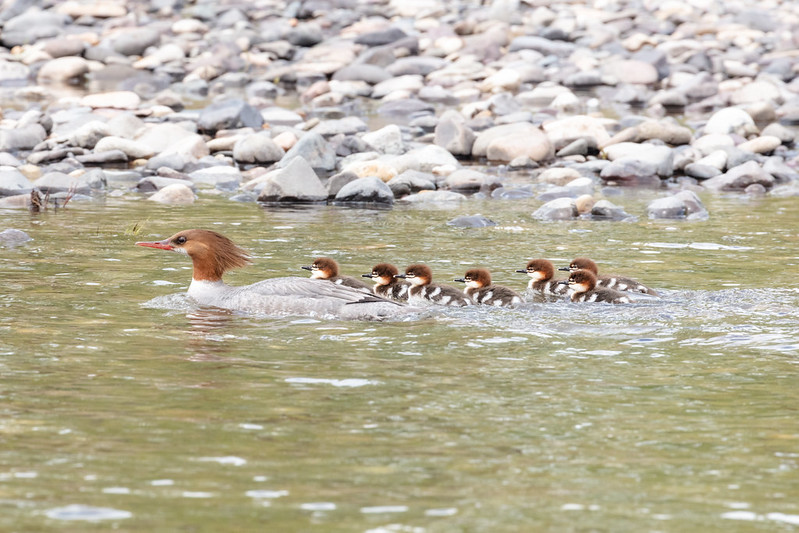
Common Merganser and chicks. Photo by Jacob W. Frank / NPS via Flickr.
Canada Goose
Description: Large grey-brown bodies with long dark necks and a white chinstrap.
Distinguishing characteristic: Commonly found harassing children and the elderly for bread scraps in many public parks, although Canada Geese found in the wild will mostly avoid humans.
Call: Honks, barks, and hisses.
Diet: In spring and summer they concentrate on grasses. During the fall and winter they eat berries and grains.
Interesting facts: Canada Geese practice “assortative mating”, where both males and females select a mate based on similar size. In the early 1900s the subspecies “Giant” Canada Goose was almost hunted to extinction. Conservation efforts were so successful that they are now mostly regarded as a nuisance. Canada Geese often take their young surfing in standing river waves to help them practice swimming in current.
Likelihood of spotting one on a half-day trip: Moderate
Likelihood of spotting one on a full-day trip: Moderate to high
Notable Sighting: We were rafting on one of the first trips of the season, and a little gosling swam right up to our rafts and followed us for at least a mile! It still had its down feathers and was honking in a high-pitched tone the entire way. It even swam right up to the support kayaker on the trip!
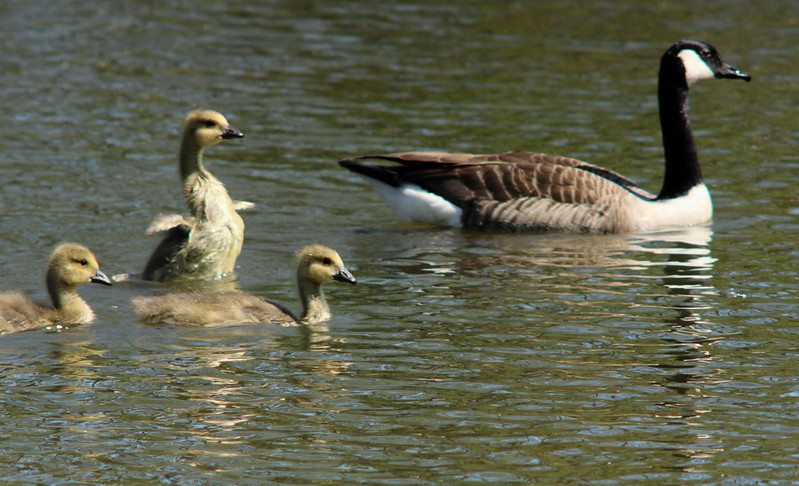
Canada Goose & goslings. Photo by Blondinrikard Fröberg via Flickr.
Mallard
Description: Males are grey with a green iridescent head and yellow bill. Females are brown with orange and brown bills. Both sexes have a distinct true blue patch bordered with white on their wing.
Distinguishing Characteristic: True blue patch on wing.
Call: Females are responsible for the stereotype of the duck “quack”. The male mallard makes a rasping hiss.
Diet: Mallards eat mostly insect and larvae during breeding season and aquatic plants and seed during migration.
Interesting Facts: All domestic duck breeds except the muscovy are ancestors of the Mallard.
Likelihood of spotting one on a half-day trip: Moderate
Likelihood of spotting one on a full-day trip: Moderate to high
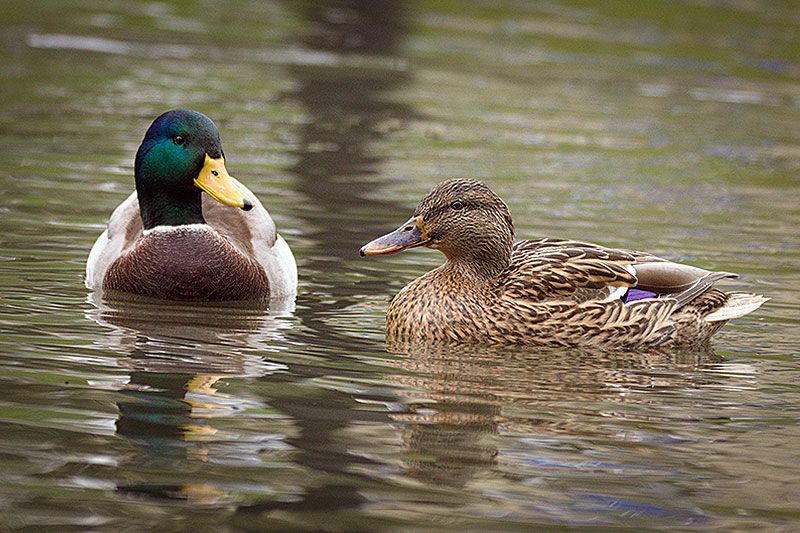
Male and female mallards. Photo by Hedera Baltica via Flickr.
Harlequin Duck
Description: (Male) The head and neck are dark slate blue with a large white crescent in front of the eye, a small dot behind the eye, and a larger oval spot on the neck. A black stripe across the crown and chestnut patches on their sides. (Female) Brownish-grey with a round white spot behind the eye, a white patch from the bill to the eye, and a small spot above the eye.
Distinguishing characteristic: Males have very unique striping around the head and wings. Females have white faces and a white spot on the neck.
Call: A mouse-like squeak or “ek-ek-ek”.
Diet: Insects, fish, and marine invertebrates.
Interesting facts: They are named after the colorful characters in the theater style Commedia Dell’arte, a 16th Century theater style notorious for its colorful masks. They are the only duck able to feed on crustaceans such as snail and mollusk because of their adapted bill.
Likelihood of spotting one on a half-day trip: Very low
Likelihood of spotting one on a full-day trip: Low to moderate
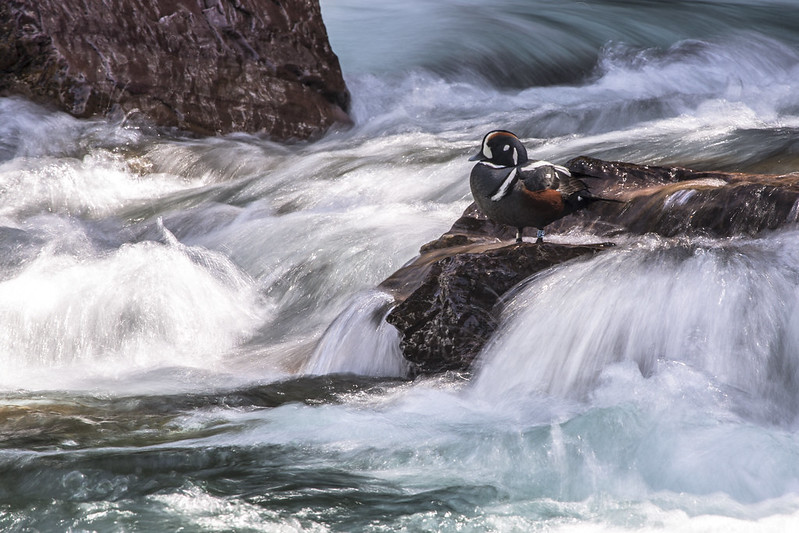
Harlequin Duck. Photo by NPS / Jacob W. Frank via Flickr.
Osprey
Description: Raptor with dark brown on top, white on bottom, with a distinct dark eye stripe.
Distinguishing characteristic: Arched, gull-like wings sometimes described as “crooked”.
Call: A melodious series of loud, sharp whistles.
Diet: >99% fish
Interesting facts: Because Osprey primarily eat fish near their nest, they can be a great indicator for contaminants in the area. Osprey nesting near Bonneville Dam showed increased levels of PCBs in 1997 & 1998. Years later a dumpsite in the Columbia River containing electrical equipment with high levels of PCBs was discovered near the Osprey nest site. Osprey are also monogamous birds, staying with the same mate, usually in the same nest, for life.
Likelihood of spotting one on a half-day trip: Very low
Likelihood of spotting one on a full-day trip: Low to moderate
Notable Signing: It was one of my first trips down the White Salmon and I was doing a training ride-along with Katie and crew. We were in the Lower section between Husum and Northwestern Lake when we saw a Bald Eagle fly into an empty Osprey nest at the top of a Ponderosa Pine. Both the male and female Osprey swooped in and tackled the Bald Eagle out of the nest, then the 3 birds tumbled toward the river until feet above the water they separated and flew in different directions.
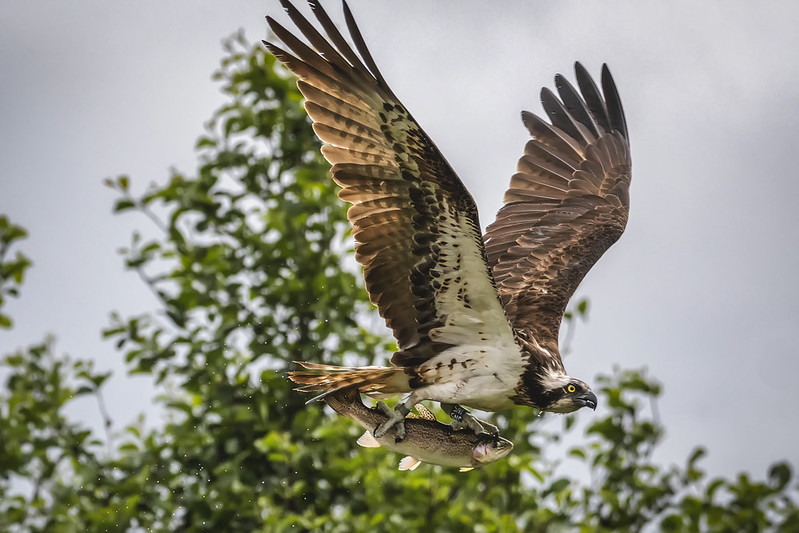
Osprey with fish. Photo by Caroline Legg via Flickr.
Bald Eagle
Description: Dark brown bodies, white head, white tail, and hooked yellow beak.
Distinguishing characteristic: A white head and tail is a tried-and-true way of identifying an adult Bald Eagle.
Call: High-pitched whistling or piping notes.
Diet: Primarily eat fish, but also eat other birds, reptiles, amphibians, rodents and other juvenile mammals.
Interesting facts: Benjamin Franklin did not appreciate the Bald Eagle as our national bird because of its thieving tendencies and its willingness to retreat when confronted by much smaller birds. The long screeching call synonymous with the Bald Eagle is actually the call of a Red-Tail Hawk, popularized by Hollywood.
Likelihood of spotting one on a half-day trip: Very low
Likelihood of spotting one on a full-day trip: Low to moderate
Notable Sighting: “During a fall evening in September on the lower-lower White Salmon, which you experience on the full-day White Salmon Rafting Trip, we were paddling out to the Mouth and came upon the gravel bar in the center of the river. There were so many bald eagles, it was as if they were pigeons! As we paddled by, one of the bald eagles stood at the edge of the gravel bar, munching on the fresh salmon it had just caught. It was really cool to see so many bald eagles at one time!” – Sharon Saltoon, Kayak Instructor
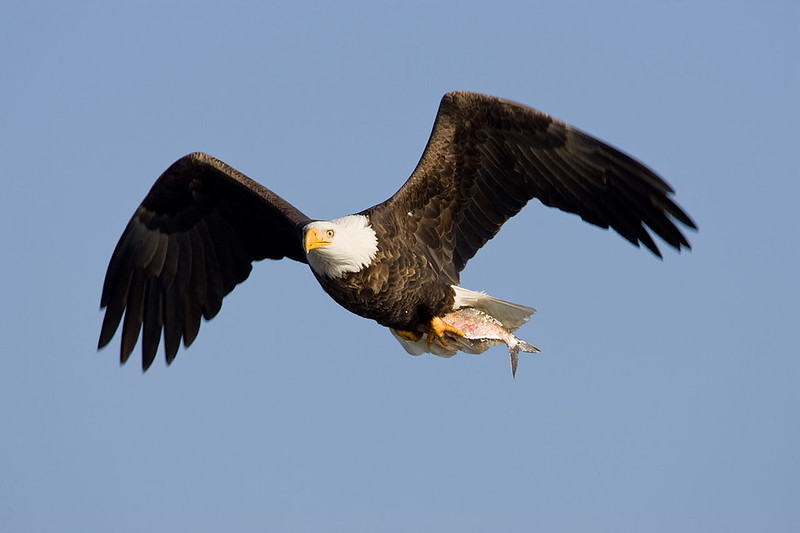
Bald eagle with fish. Photo by USFWS via Flickr.
The White Salmon is a wild river, abundant with wildlife so you never know what you’re going to see during your adventure. In some cases guests are treated to unique events such as the notable sightings we’ve witnessed over the years. Whether you choose a half-day rafting trip or a full-day rafting trip on the White Salmon River, you almost always encounter at lease one of these species! Either way, you’re sure to experience the classic beauty of the rivers in the Columbia Gorge!

